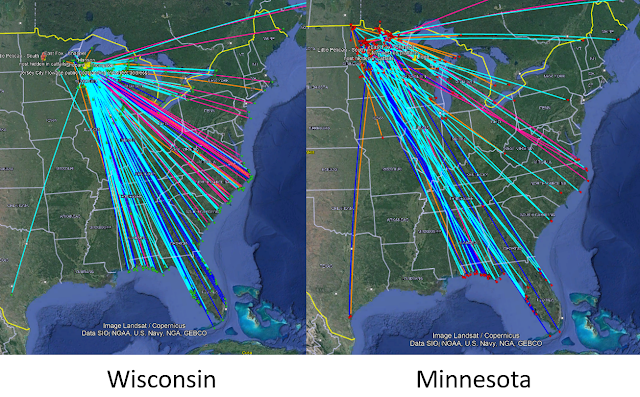*Check out the Museum's Facebook or Instagram Reels for videos from Hawaii!*
Whenever I visit the smooth, gray rocks on the North Shore of Lake Superior, I find myself crouching low to examine the colorful patchwork of lichens who have made their home in such a seemingly perilous place. I never expected to do the same thing on Hawaii!
 |
| Lichens on basalt with Lake Superior in the background. Photo by Emily Stone. |
The basalt bedrock in the Northwoods hardened from lava that poured out of the Mid-Continent Rift 1.1 billion years ago. (If you want to learn more about the rift, visit our Northwoods Rocks exhibit!) While making plans to visit Hawaii last month, I knew that I’d be seeing much younger basalt, especially on the Big Island, where Kilauea erupted as recently as December 2022. What I didn’t expect was such an abundance of lichens that the rocks looked fuzzy!
 |
| Aptly named “the lava-colonizing lichen,” this pioneering organism is among the first to grow on basalt rocks after they cool from volcanic eruptions. Photo by Emily Stone. |
Anytime I talk about lichens, I brag about how the symbiotic partnership between fungus and algae allows them to live where neither partner could survive alone, to colonize bare rock, and even to survive in outer space. The fungus provides a structure, and an anchor. The algae do photosynthesis and make food for them both out of sun, water, and air. Sometimes instead of algae, the partner is a cyanobacteria, who can do photosynthesis AND fix nitrogen out of the air. Plus, lichens are wind-dispersed, and as I wrote last week, wind is one of the main agents that brings new life to the Hawaiian Islands.
The first lichens I noticed weren’t growing on rocks, though, they were clinging to the trunks and branches of trees. The fuzzy, pale green strings were so dense they made the trees look like stuffed animals who had been loved and washed within an inch of their lives.
Fuzzy trees!
 |
| This view from a kīpuka on Mauna Kea in Hawaii highlights the age of the pale green lichen-covered forest in the foreground, with a background of newer lava flows. Photo by Emily Stone. |
Kīpukas are essential reservoirs of biodiversity in Hawaii. Not only do they provide the source populations for revegetating fresh lava flows after volcanoes erupt, their isolation helps to protect them from invasive species. One kīpuka in Hawaii Volcanoes National Park is home to more native tree species per acre than any other forest in the park (and probably on the whole island). The diversity of lichens is far greater. Because they are sometimes hard to find and difficult to identify, the true number of lichen species in Hawaii may be impossible to ever measure, but it is likely more than 800 species, with at least 30 percent of those only existing in Hawaii.
 |
| Here you can see the forested kipuka in the background, with newer lava rocks in the foreground. Photo by Emily Stone. |
While lichens make up a good part of the lushness and biodiversity in mature kīpukas, they are also key to helping life start over from scratch on the surrounding lava. On our way to explore a kīpuka along the Kaulana Manu Nature Trail, we passed by areas of younger lava rocks that weren’t yet covered in forest. They were, however, fuzzy with lichen! (see photo above)
The first species to arrive on freshly cooled lava flows is Stereocaulon vulcani, the lava-colonizing lichen. Fragments of lichen thalli (leaves) from other areas may break off and blow in, or the fungal partner within the lichen may produce dust-like spores that sail around the globe in the upper atmosphere. They especially thrive on the rugged a’a’ lava flows, where abundant surface area breaks down to release nutrients, and little holes left from gas bubbles collect rainwater.
These lichens can fix nitrogen—an essential ingredient for plant growth—while also breaking down rocks, building up soil, holding onto moisture, and providing cozy spots for other seeds and spores to germinate. The lichens shelter insects, which attract lizards and birds, the birds bring more seeds, and eventually a forest grows. The forest contains many more niches than the bare rock, so more and more species of lichens become established there, until they are carpeting the trees like the first ones I saw.
Lichens grow relatively quickly in the rainy areas of the islands. The ones I saw on the trees were sparkling with droplets swept out of thick clouds, which benefits the rest of the forest, too. They also enjoy the mild climate. Even though (according to one researcher,) at high elevations lichens experience “summer every day and winter every night,” I’m pretty sure that’s more conducive to growth than the Northwoods’ schedule of “winter for 6 months of the year.”
 |
| This looks just like our Usnea, or Old Man's Beard Lichen! |
On the wave-washed, basalt shores of Lake Superior, it’s the bright orange Elegant Sunburst Lichen who first colonizes the rocks. Constant wave action prevents much more from growing there, for now. But if wave disturbance ever ceases, more and more lichens will move in there, too, building up soil and setting the stage for forests to grow. From afar, Hawaii seems really different from the Northwoods. Upon closer examination, I found all sorts of natural connections.
Emily’s award-winning second book, Natural Connections: Dreaming of an Elfin Skimmer, is available to purchase at www.cablemuseum.org/books and at your local independent bookstore, too.
For more than 50 years, the Cable Natural History Museum has served to connect you to the Northwoods. Our exhibit: “The Northwoods ROCKS!” is open through mid-March. Our Winter/Spring Calendar of Events is ready for registration! Follow us on Facebook, Instagram, YouTube, and cablemuseum.org to see what we are up to.



.jpg)



.jpg)

.jpg)























.jpg)




